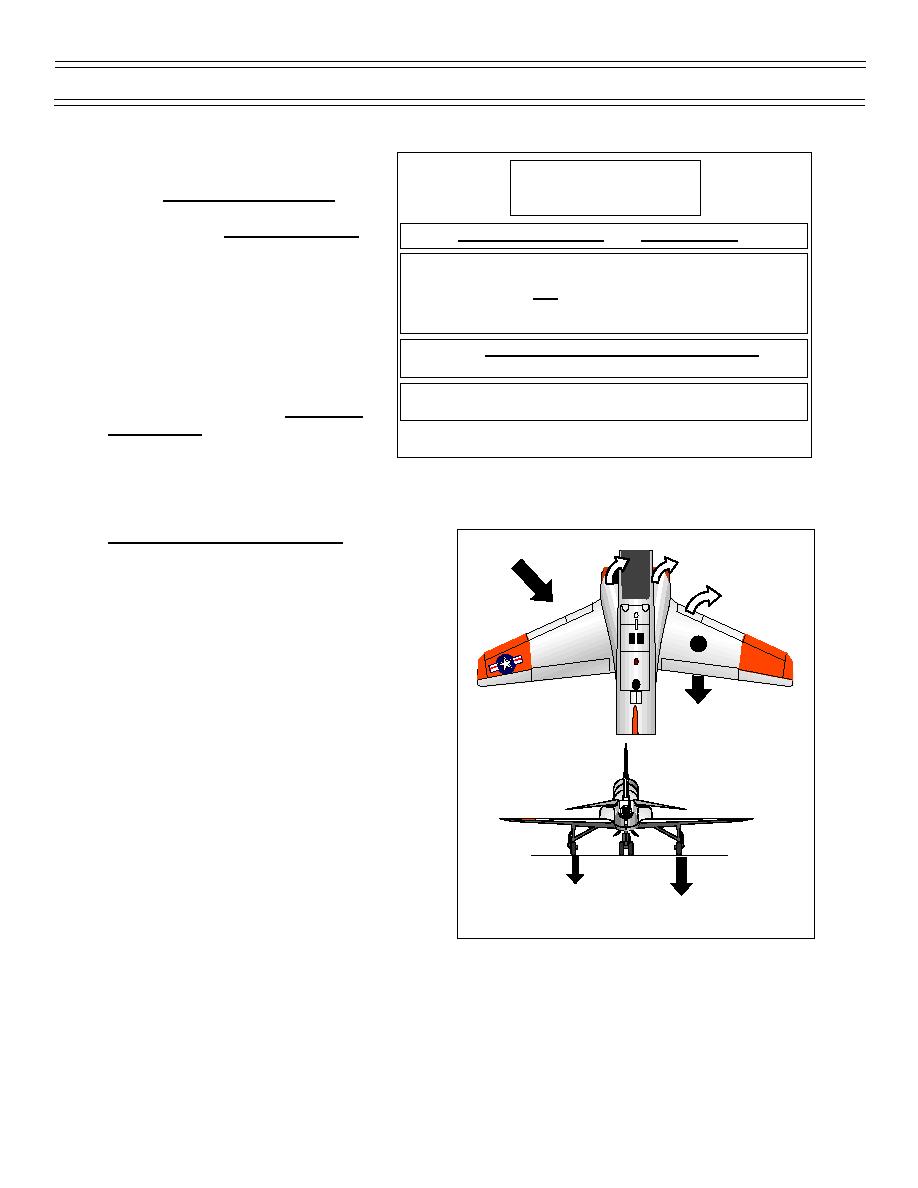
Aero Chapter 04, Stability
T-45 Aerodynamics Student Workbook
SPIRAL DIVERGENCE
COUPLING
Bank angle and small sideslip is induced
at stall. Strong directional stability
(SPIRAL DIVERGENCE)
attempts to align the nose with the
relative wind, but weak lateral stability
STRONG DIRECTIONAL CONTROL WITH WEAK LATERAL STABILITY
lags in righting the aircraft. The bank
angle keeps the relative wind moving off
BANK ANGLE AND SMALL SIDESLIP INDUCED AT STALL. STRONG
DIRECTIONAL STABILITY ATTEMPTS TO ALIGN THE NOSE WITH
the nose. The aircraft continues to chase
THE RELATIVE WIND, BUT WEAK LATERAL STABILITY LAGS IN
the relative wind and will develop a tight
RIGHTING THE AIRCRAFT. THE RESULT IS THAT THE BANK ANGLE
descending spiral. This is an example of
KEEPS THE RELATIVE WIND MOVING OFF THE NOSE
negative dynamic directional stability
EXAMPLE OF NEGATIVE DYNAMIC DIRECTIONAL STABILITY AS
(Figure 75).
RATE OF TURN IS INCREASING
The T-45 has demonstrated a slowly
DIRECTIONAL STABILITY - POSITIVE STATIC/NEGATIVE DYNAMIC
divergent spiral mode with asymmetric
LATERAL STABILITY
- POSITIVE STATIC/NEUTRAL DYNAMIC
store loadings. To correct this condition,
Figure 75: COUPLING (SPIRAL DIVERGENCE)
the pilot need only raise the wing with
aileron and the spiral will stop
immediately. Because this spiral is slow, and there is no oscillation, the directional stability is usually
designed stronger than the lateral stability in most aircraft.
T-45 LANDING IN A CROSSWIND
Pilots must be alert while landing the T-45 in a
Yawing Moment About
WIND
crosswind. After landing, the T-45 does not fare
Downwind Gear
into the wind as most aircraft do but turns away
from the crosswind. The upwind wing will
generate more lift and rise which places more
weight and wheel drag on the downwind landing
gear. This additional drag produces more friction
at the downwind wheel and the T-45 TURNS
AWAY from the crosswind (Figure 76).
The NATOPS crosswind procedure should be
studied but is summarized as follows: The aircraft
is flown in a crab on final and straightened out so
as to land straight down the runway with the
rudder pedals centered. The nose wheel steering
will engage when one main gear and the nose
strut compress, so it is important to have the
rudder pedals centered to avoid a swerve. On
Less Drag
More Drag
touchdown the stick is moved into the wind.
The crab method is better during the approach
Figure 76: LANDING IN A CROSSWIND
because the yaw damper fights the rudder pedal
inputs of the cross-controlled method. Full flaps
are recommended for crosswind landings, but the approach and roll-out characteristics with half flaps are
the same as full flaps except for the speed increase of 18 kts.
The maximum T-45 NATOPS crosswind limit for takeoff and landing is 20 kts, 15 kts if the runway is wet.
Ten knots is the maximum for a section takeoff. Training Air Wing SOP limits the student crosswind
component to 10 kts. Carefully read the crosswind landing section in NATOPS.
Page 48
(7-99) Original



 Previous Page
Previous Page
